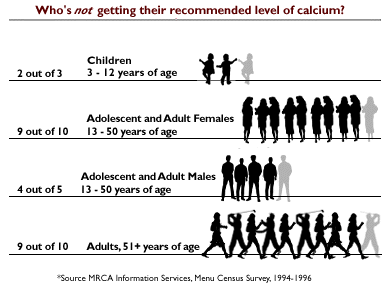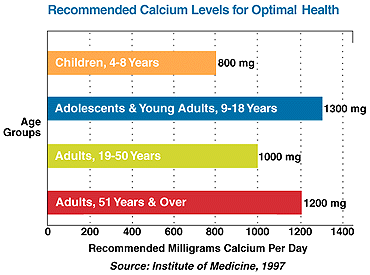What are
cookies without milk?
What is pizza without cheese?
What is a birthday without ice cream?
Don't dairy foods add to the fun in life?
Milk, cheese and ice cream
- the foods you loved as a kid - are
important to adults, too. So if you think
dairy foods are kid stuff, time to bone up
on dairy foods and calcium.
Calcium
Helps...
- Children build strong
bones.
- Adolescents and young
adults achieve peak bone mass.
- Older adults minimize
the normal loss of bone calcium.
- People of all ages
maintain normal blood pressure.
How About You?

Getting
Enough Calcium
Made with wholesome milk,
dairy products are primary food sources of
calcium. And you need calcium throughout
your entire life. How much do you need? Take
a look.

Q: How do I convert
calcium information on food labels from %
Daily Value to milligrams calcium?
A: Simply replace the % sign with a zero.
For example, if a food contains 10% DV for
calcium, this is about 100 milligrams of
calcium per serving. The recommended daily
value (DV) for calcium used as the basis for
nutrition labeling is 1,000 milligrams per
day.
Choose
Foods with Calcium
Calcium-filled dairy foods
can be enjoyed at every meal. And if keeping
tabs on calories and fat has you cutting
back on dairy foods, try the many lower fat
and fat free varieties of cheese, yogurt and
other milk products
Remember too, that
nondairy foods can deliver calcium. For
example, tofu, dark-green leafy vegetables
(kale, mustard greens, turnip greens),
almonds and tortillas (made from
lime-processed corn).
Sensible
Ideas for Lactose-Sensitive People:
- Eat smaller servings of
dairy products with a meal, rather than on
an empty stomach.
- Choose fermented milk
products, such as yogurt, which contain
live and active cultures that break down
lactose.
- Choose aged natural
cheeses, such as cheddar and Colby, which
have almost no lactose.
- Read ingredient lists
on food labels.
- Ask a physician or
dietitian to help determine the amount of
lactose per meal that is acceptable for
you.
Learn About
Label Terms for Calcium
Here's what food product
labels tell you about calcium:
| Good
Source/Provides/Contains Calcium |
At least 10% of the
daily value for calcium per serving. |
| High/Rich/Excellent
Source of Calcium |
20% or more of the
daily value for calcium per serving. |
